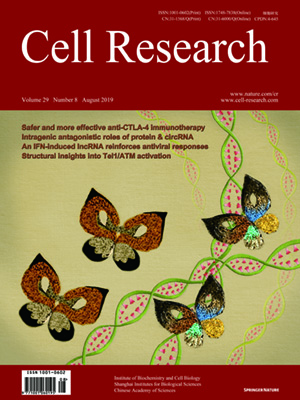
Volume 29, No 8, Aug 2019
ISSN: 1001-0602
EISSN: 1748-7838 2018
impact factor 17.848*
(Clarivate Analytics, 2019)
Volume 29 Issue 8, August 2019: 655-665 | Open Access
ORIGINAL ARTICLES
Structural basis of allosteric regulation of Tel1/ATM kinase
Jiyu Xin1, Zhu Xu1, Xuejuan Wang 1,2, Yanhua Tian3, Zhihui Zhang1 and Gang Cai 1,2
1First Affiliated Hospital of USTC, School of Life Sciences, University of Science and Technology of China, Hefei 230027 Anhui, China; 2Hefei National Laboratory for Physical Sciences at Microscale and CAS Center for Excellence in Molecular Cell Science, Chinese Academy of Sciences, Hefei 230026 Anhui, China and 3College of Life Science and Technology, Huazhong University of Science and Technology, Wuhan 430074 Hubei, China
Correspondence: Gang Cai (gcai@ustc.edu.cn)These authors contributed equally: Jiyu Xin, Zhu Xu and Xuejuan Wang
ATM/Tel1 is an apical kinase that orchestrates the multifaceted DNA damage response. Mutations of ATM/Tel1 are associated with ataxia telangiectasia syndrome. Here, we report cryo-EM structures of symmetric dimer (4.1 Å) and asymmetric dimer (4.3 Å) of Saccharomyces cerevisiae Tel1. In the symmetric state, the side chains in Tel1 C-terminus (residues 1129–2787) are discernible and an atomic model is built. The substrate binding groove is completely embedded in the symmetric dimer by the intramolecular PRD and intermolecular LID domains. Point mutations in these domains sensitize the S. cerevisiae cells to DNA damage agents and hinder Tel1 activation due to reduced binding affinity for its activator Xrs2/Nbs1. In the asymmetric state, one monomer becomes more compact in two ways: the kinase N-lobe moves down and the Spiral of α-solenoid moves upwards, which resemble the conformational changes observed in active mTOR. The accessibility of the activation loop correlates with the synergistic conformational disorders in the TRD1-TRD2 linker, FATC and PRD domains, where critical post-translational modifications and activating mutations are coincidently condensed. This study reveals a tunable allosteric network in ATM/Tel1, which is important for substrate recognition, recruitment and efficient phosphorylation.
https://doi.org/10.1038/s41422-019-0176-1
FULL TEXT | PDF
Browse 1104


